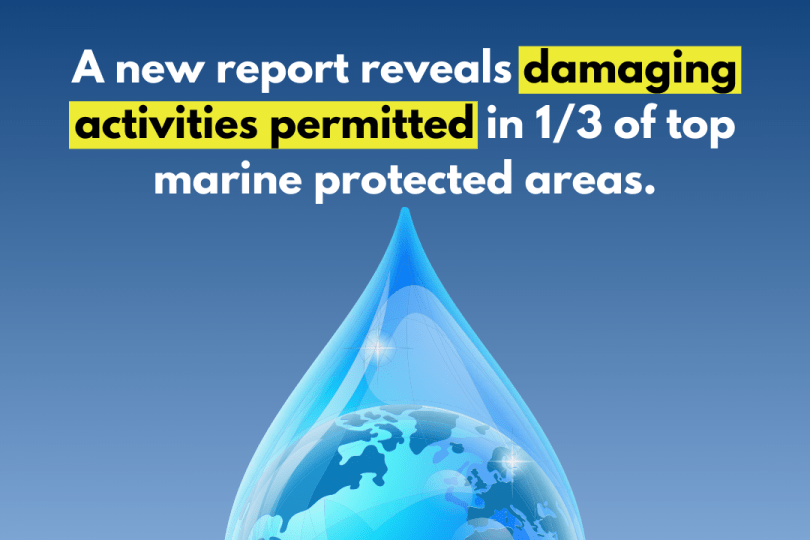Hameed co-authors report finding ocean protection quality lags behind quantity
Editor’s note: original press release by the Marine Conservation Institute.
A new analysis of the world’s largest 100 marine protected areas (MPAs) published in Conservation Letters suggests that governments are falling short on delivering the promise of effective biodiversity protection due to slow implementation of management strategies and failure to restrict the most impactful activities.
The assessment, titled “Ocean protection quality is lagging behind quantity: Applying a scientific framework to assess real marine protected area progress against the 30 by 30 target,” was conducted by an international team of 11 researchers. The study analyzed the capacity of the world's 100 largest MPAs to deliver positive biodiversity outcomes, which collectively account for approximately 90% of the total marine protected area globally. The research evaluated the key indicators for success, including management and permitted human activities, based on criteria established by “The MPA Guide: A framework to achieve global goals for the ocean,” published in Science in 2021.
MPAs are defined areas of the ocean managed to achieve the long-term conservation of nature, and they aim to protect and recover marine biodiversity, promote healthy and resilient ecosystems, and provide lasting benefits to both people and the planet. As the world strives to protect at least 30% of the ocean by 2030—a target set by a United Nations’ international agreement—this assessment provides an important reminder that achieving this goal requires both increased quantity and improved quality of marine protected areas. The assessment's findings raise questions about the effectiveness of current conservation efforts in achieving the declared goals of marine protection.
Currently, the World Database on Protected Areas from the United Nations Environment Programme World Conservation Monitoring Centre lists more than 18,000 marine protected areas covering 30 million square kilometers (or about 8%) of the global ocean. The 100 largest MPAs overwhelmingly account for most of this total – about 26.3 million square kilometers (or about 7.3%) of the global ocean.
The MPA Guide links scientific evidence to conservation outcomes, creating a framework to categorize MPAs and whether MPAs are set up to successfully contribute to conservation outcomes. While MPAs are commonly considered proven and effective tools for ocean conservation, the report highlights wide variations in design, goals, regulations, and management. For instance, some MPAs allow activities such as oil and gas exploration, industrial fishing, or aquaculture, while others are highly protected. This mismatch between the declared goals of an MPA and the likelihood of delivering those outcomes raises concerns about the efficacy of these protected areas.
According to the analysis, one-third of reported MPA area allows industrial-scale, damaging activities, and another quarter of the area (6.7 million square kilometers) is not yet implemented on the water. Without regulations or management, these areas are no different from surrounding waters and cannot deliver conservation benefits. Including these areas in the current tally of marine protection results in a misguided understanding of human impacts on the ocean and marine conservation progress.
“What a tragedy it will be if the global community comes together and achieves 30x30 by covering 30% of the ocean in MPAs that don’t have strong enough regulations to safeguard marine ecosystems or are otherwise ineffective,” said Sarah Hameed.

We have to do better to conserve the biodiversity of our ocean – we need to ensure that our MPA efforts are meaningful.
Sarah Hameed
The study’s authors also point out that large MPAs disproportionately exist in remote areas and overseas territories, leaving important habitats and species unprotected and vulnerable throughout much of the ocean.
“Successfully conserving ocean biodiversity, and its benefits to human wellbeing, from the consequences of destructive activities can only be achieved with a clear understanding of global progress,” said Dr. Kirsten Grorud-Colvert, associate professor at Oregon State University, who co-authored the assessment and was lead author of The MPA Guide. “This assessment identifies challenges but also points to a clear, evidence-based path to achieve actual and effective protection and to provide lasting, just support for a healthy and resilient ocean.”
Dona Bertarelli, a philanthropist, ocean advocate, and Patron of Nature for the International Union for Conservation of Nature said: “Growing understanding, support and momentum toward area-based global targets such as 30 by 30 are crucial for moving the dial on ocean conservation – but only provide meaningful progress when effective. Well-designed, managed, and enforced MPAs can provide enormous benefits for both people and nature. Now is the time for collective action – before it’s too late for our ocean and planet.”
Read the open access article here.
Visit the article landing page for a summary with links to additional information.
